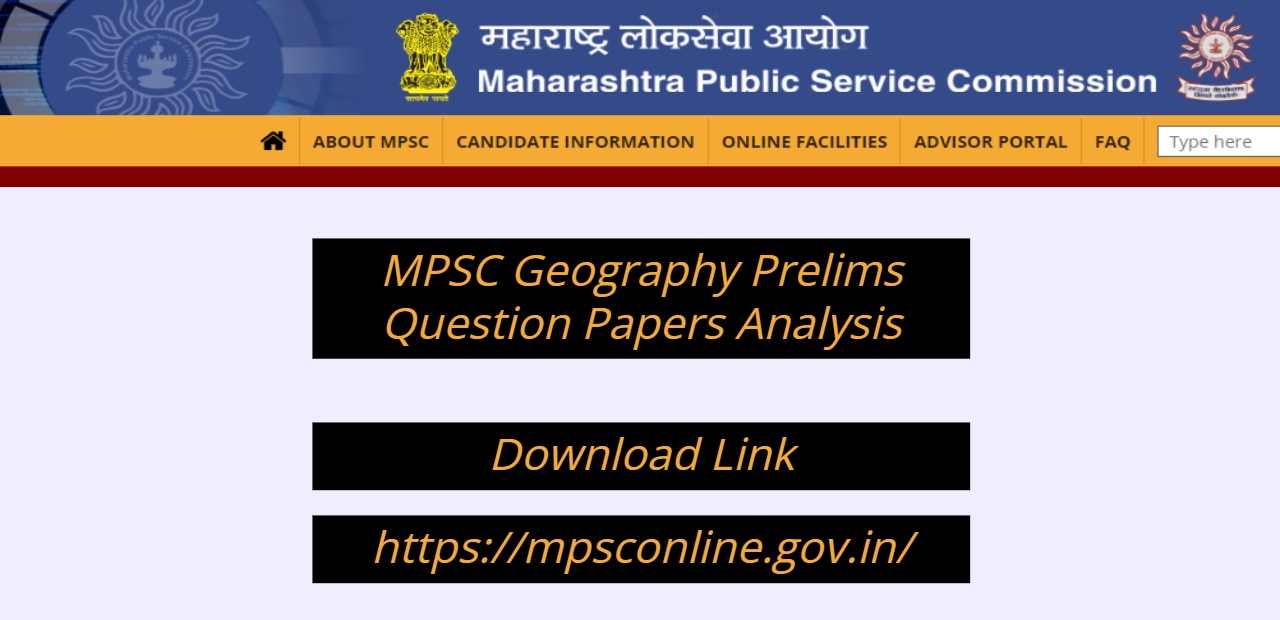MPSC Geography Prelims Question Papers Analysis – The prestigious and well-known Maharashtra Public Service Commission will shortly hold the MPSC Combined Group B test 2022, a subordinate services exam, to choose qualified applicants for various positions, including Assistant Section Officer, State Tax Inspector, etc. View the analysis of the MPSC Combined Prelims subject-wise weighting and previous year’s question trends for the MPSC Combined Group B last year’s exam, held from 2017 to 2019. Studying the MPSC Geography Prelims Question Papers Analysis is crucial since geography is a topic that is equally vital in every MPSC Exam.
However, the students must study the MPSC Geography Prelims Question Papers Analysis, the syllabus, and other topics connected to the specified themes and their subtopics, supposing the following points.
MPSC Prelims Geography Syllabus:
Syllabus :
Natural, Social, and Economic Geography of Maharashtra, India, and the World (Maharashtra, India, and World Geography-Physics Social, Economic Geography of Maharashtra, India, and World)
MPSC Geography Prelims Question Papers Analysis:
All of the geography-related questions on the MPSC Prelims Exam in the years 2013 through 2019 covered the same topics as these, according to the MPSC Geography Prelims Question Papers Analysis component.
Thus, examining the MPSC Geography Prelim Question Paper Analysis becomes crucial. Geography Sub Topics break down the MPSC Geography Prelim Question Paper Analysis.
Prelims Exam:
- This test has an objective format.
- This document will apply to every post.
- The exam lasts for one hour.
- There are 100 questions in the test worth 100 marks.
Geography:
- Geography is a significant subject that is readily prepared with the appropriate methodology. You may offer yourself the best opportunity to get excellent exam scores by combining the fundamentals of effective study techniques with targeted actions to increase your geography knowledge and aid in your memory of terminology and facts.
- Learning maps and directions is essential to become proficient in geography.
- Consider creating original study methods, such as mnemonic devices and flashcards.
MPSC Geography Prelims Question Papers Analysis PDF: (PDF LINK)
2013:
- Igneous section
- River landforms
- Global warming
- Equatorial climate
- Descending sequence of river basins
- Watersheds (map)
- Garo Khasi
- Jaitia Hills (map)
- Soil erosion
- Alluvial soils
- Flood levels
- Cloudbursts
- Animal wealth
- Sugar from sugarcane
- Mumbai’s High Availability of oil fields
- agricultural fields
2014:
- Types of Volcanoes
- Solar Energy
- Types of Forests
- State with the Most Forest Areas
- Rivers and Waterfalls
- Nilgiri Mountains
- Various Gulfs
- Ennore Port
- Shifting Agriculture
- Tea Plant
- Tribal Tribes
- Tij Festival
2015:
- Earth’s interior
- Volcanic landforms
- Perennial River
- Colorado River
- Inclined Plateau
- Tsunamis
- Muga Silk Production
- Gold Revolution
- Jyotirlinga
- Continent of Africa
- Vatican City
- Mars
2016:
- El-Nino
- Types of Forests
- Ghagra River
- Himalayan Peaks
- Deserts
- Earth’s Environment
- National Highways
- Cotton Mills
- Ningol Chakouwa
- Sarhul
- Nuakhai
- Lohri Festival
- Anuva Tribe
- Hydroelectric Project
- Land Boundary of India
- Lake Titicaca
2017:
- Climate Classification of Earth’s Interior, Earthquake, La Niño, Condensation, Convergence, Trivarta (Map)
- Local Winds (Map), Bora Winds (Wind and Their Types)
- Rivers and sources, Earth origin theories, Seasons and dates, Sea salinity, Lines dividing islands
- Longest Distance Railways, Sarhool Festival, Classical Dance, Islands and Features, Winds (Types)
2018:
- Volcanic landforms, underground movements, chemical fission, relative and absolute humidity, equator, rain shadow region, convective winds.
- Himalayan and peninsular rivers, rotation of the earth, ocean salinity, fishing,
- Earth diameter, coastal area, location of India (longitude and latitude).
2019:
- Theory of plot wine, Earth’s interior, Rock types, Landforms (diagram), Land erosion, Local winds, North-east monsoon winds (map), Deforestation,
- River and riparian towns, Deccan Plateau, Soil types, Transport, Firsts in Maharashtra, Rock types in Maharashtra.
Major factors:
- Natural structure
- Climate
- River systems
- Soil
- Forests
- Agriculture
- Industry
- Natural resources (especially energy, minerals, water, etc.) ),
- Population,
- Colonization,
- Environment and Natural Disasters.
We will go over the questions in each of these sections again. Let’s begin with the natural structural element. In the previous 56 years, the following inquiries concerning this aspect have been made.
- Landslides occur often in the Himalayas. Talk about the causes of this and offer appropriate countermeasures. (2016: 12 points)
- Describe how the myriad islands comprising the Indonesian and Philippine Archipelagos were formed. (Marks: 2012–10)
- Explain the relationship between fold mountains and the global distribution of earthquakes and volcanoes. (Marks: 2014–10)
- Rivers in the Western Ghats do not create deltas. (Marks: 2013–5)
- Explain why landslides occur more frequently in the Himalayas than in the Western Ghats. (2013 – 5 points)
Read Also – MPSC Rajyaseva Exam Books 2024
